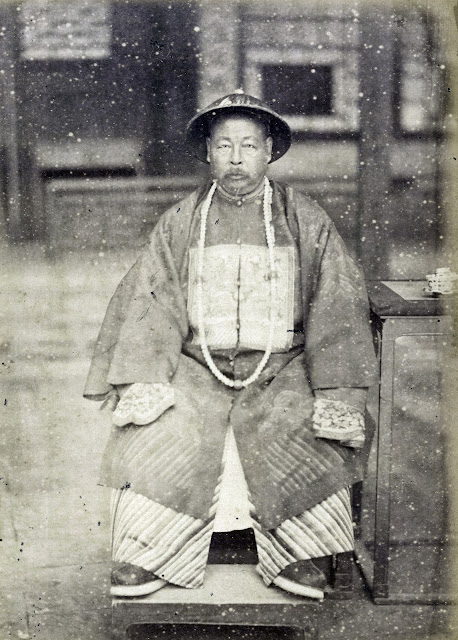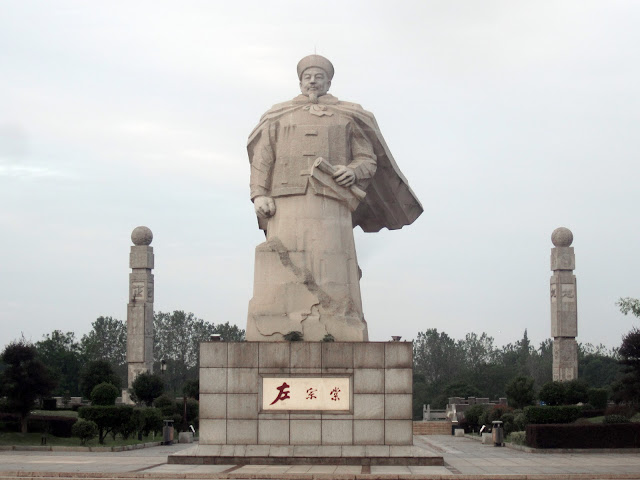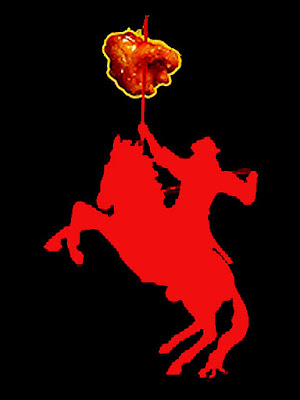左宗棠
This picture of Zuo Zongtang was taken in 1875 by Adolf-Nikolay Erazmovich when Zuo was Governor-General of Shan'gan. Zuo Zongtang is quite famous in China for his role in Qing dynasty military affairs, most notably suppressing the quasi-Christian Taiping rebellion in the 1860s. The Encyclopedia Britannica gives this summary.
Zuo Zongtang, Wade-Giles romanization Tso Tsun-t’ang, (born Nov. 10, 1812, Xiangyin, Hunan province, China—died Sept. 5, 1885, Fuzhou, Fujian province), Chinese administrator and military leader, one of the scholar-officials who worked to suppress the great rebellions that threatened the imperial government during the second half of the 19th century. Zuo’s efforts helped revive the declining Qing (Manchu) dynasty (1644–1911/12) and reestablished the Chinese position in Central Asia. -- Encyclopedia Britannica
A statue in Zuo Zongtang Cultural Park in Yueyang, Hunan Province, shows Zuo with his cape billowing out behind him like a super-hero.
(Cropped and adjusted by ACB)
And here's a clip from a Chinese Menu, aptly pointing out the American origins of the dish.
But General Zuo is most famous, in his Wade-Giles spelling, as the General Tso after whom General Tso's Chicken, 左 宗 棠 鸡, or just 左 宗 鸡, is named. 左 宗 棠 is the general's name and 鸡 (隻) is jī for chicken. I guess 左 宗 鸡 is an abbreviation. The photo below is by Evan Joshua Swigart (TheCulinaryGeek) from his book 101 Chicken recipes.
Fuchsia Dunlop in her 2005 paper, at a conference called Authenticity in the Kitchen, described General Tso's Chicken this way:
General Tso’s chicken is a wok-cooked dish, in which large slices of chicken (usually the dark meat) are battered, deep-fried and then tossed in a sour-sweet sauce laced with dried chillies. The precise constituents of the sauce vary: some recipes include hoisin sauce, some tomato paste. The dish is so popular that it appears not only on the menus of supposedly Hunanese restaurants, but also of more mainstream Chinese establishments.
She summarizes General Tso's biography,
The dish is named after General Zuo Zongtang (alternatively transliterated as Tso Tsung-t’ang), a formidable nineteenth-century general who is said to have enjoyed eating it. Zuo was born in 1812 in Xiangyin County, Hunan Province, and died in 1885 after a glittering career in the Qing Dynasty civil and military administration. He led successful military campaigns against the Taiping rebels, a quasi-Christian sect whose revolt tore China apart in the mid-nineteenth century He crushed another peasant revolt by the Nian Army, as well as an uprising by Hui Muslims in Northwest China, and is widely famed for recapturing the great western desert region of Xinjiang from rebellious Uyghur Muslims. The Hunanese have a strong military tradition, and General Zuo is one of their best-known historical figures, alongside Zeng Guofan (the founder of the Hunan Army), and the communist leader Mao Zedong.
and remarks that “What is clear is that the dish is all but unknown in Hunan itself.”
It is generally said that the dish was invented in Taiwan by Hunanese restauranteur Peng Chang-kuei, 彭長貴, in the 1950s and brought to American by him in 1973 when he opened a restaurant on 44th street in New York. There is also a claim that it was introduced to American in 1972 by a chef named T. T. Wang, who may or may-not have copied it from Peng. For more on the history of General Tso and his Chicken read Fuchsia Dunlop's 2005 article in Authenticity in the Kitchen or her 2007 article in the New York Times, hear Jennifer 8. Lee's 2008 TED talk, and see the 2014 documentary film The Search for General Tso.






No comments:
Post a Comment